

One of the key benefits of cloud computing is that it has given organizations the ability to more quickly accelerate applications to market, providing increased business agility. That means organizations can potentially reach the market faster than ever before, increasing their profits and success in the process.
There’s a flip side to that coin, however. With a larger user base and more frequent releases comes greater potential for impactful cyberattacks, any one of which can seriously damage a brand’s reputation and company profitability.
The need to join cloud security and app security together is clear. At the end of the day, if an organization’s cloud infrastructure isn’t as secure as it could be, then its apps are at risk as well.
Application security is the set of practices and processes that helps maintain the integrity and availability of an application. It’s important because it ensures that an organization’s data is safe from malicious attacks, which can be costly in terms of both time and money.

The risks of application security are pretty straightforward: When a company doesn’t have a secure application, they leave their business vulnerable to identity theft, data breaches, fraud, and other forms of cybercrime. That means hackers can access sensitive information like credit card numbers or personally identifiable information (PII). They can also manipulate internal systems to steal funds from user accounts or cause other damage that costs time and money to fix, and is sometimes impossible to fix altogether.
Making apps compatible with the cloud is a major concern for many companies because they don’t want their software to depend on any single point of failure. That’s why cloud-native apps are so popular. In theory, they’re scalable and resilient so they can run anywhere without compromising performance or reliability.
Designing cloud-native applications, however, is no easy task. It requires developers to think differently about security once in-house servers are no longer involved in processing data or running applications. Instead, everything happens in public clouds like AWS and Azure, where there’s a possibility for malicious actors to gain access to sensitive information.
But only if things aren’t done right.
Cloud-native security is a new approach to application security that is designed to work with cloud native applications. Cloud-native security takes a holistic look at the application and secures it from the ground up, rather than attempting to patch vulnerabilities after their discovery.
The most important thing to understand about cloud-native security is that it’s not just about identifying vulnerabilities in the application code. It’s also about making sure the entire application is secure as a whole: from its design, to its architecture and deployment, to its ongoing maintenance and development security.

As the cloud-native application ecosystem evolves, so do its security needs. The last few years have seen a dramatic increase in the adoption of cloud-native architectures, with more and more organizations moving to this new way of building software. This is great news for the industry as a whole, but it also means that app developers need to ensure their applications are secure and robust enough to meet these new demands.
Cloud-native security allows developers to:
• Build secure apps from the ground up
• Use containers to isolate processes from each other
• Centralize logging and monitoring into one system
• Automate security testing into the software supply chain itself so that it’s easy and painless
• Incorporate identity management into their applications so they can easily access data from multiple sources
In other words, cloud-native security allows application developers to benefit from the cloud’s fast market deployment without sacrificing security in the process.
Designing apps for cloud-native security means taking the lessons learned from traditional security architectures and applying them to a new way of thinking about how apps are built, deployed, and accessed. Specifically, it’s about taking advantage of the tools and patterns that have emerged in recent years in order to build a more secure application.

Cloud-native apps are built on microservices, which are small independent components that communicate with each other over APIs. This architecture makes them easier to update than monolithic apps, and it allows them to be distributed across multiple servers and scaled up or down depending on demand.
Cloud-native devops have many advantages over traditional monolithic applications:
• Higher scalability
• Easier to build and maintain
• Lower cost of ownership
The challenge with designing apps for cloud-native security is that it needs to be done differently than how we designed apps in the past. Traditional software development focused on the application itself. Cloud-native applications focus on the whole environment, from the underlying infrastructure to the end-user experience.
Application developers need to invest time and resources into adapting their work for the cloud, but not every organization has the resources or expertise to make those changes. The result is that many organizations are finding themselves in a position where they must choose between spending money on additional resources…or accepting risk.
Unless there’s a way around that challenge altogether.
The cloud is the present and future of computing, and it’s going to be where businesses focus their efforts if they want to remain competitive. Linking security directly to the cloud and building software security so it can run in a microservice environment helps ease many concerns organizations have about running applications in a public cloud like AWS.
But remember, it’s not just about protecting data. It’s also about protecting the app’s reputation, and that of the company that built it. The more developers do to make their app safe and secure, the better it will be for everyone who uses the app.
Working with third-party experts who know cloud native security inside and out can provide app developers with an enormous advantage. They can help to:
• Find code vulnerabilities in the app before they become a problem
• Make sure the application meets the standards of devsecops and can withstand attacks
• Build features that prevent data breaches in the first place
Kiuwan, for example, can help developers plan and execute applications that are designed for the cloud from the start, allowing for easier security integration and management later on. Get in touch with us to schedule a demo and learn more about how we can help your team.



